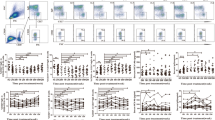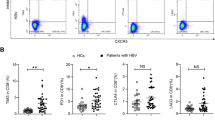Abstract
Background
A subset of interleukin (IL)-10-producing regulatory B (Breg) cells that suppress T-cell-mediated immunity was recently identified; however, their role in chronic hepatitis B (CHB) remains elusive.
Aim
To explore the possible role of Breg in the interaction with Th cells and consequent pathogenesis of CHB.
Methods
The prevalence of Breg as well as 3 major effector T-cell subsets—CD4+CD25highFoxp3+ regulatory T (Treg) cells, T helper 1 cells (Th1), and T helper 2 cells (Th2)—was assessed in the peripheral blood of 31 patients with CHB, 28 patients with acute hepatitis B (AHB), and 25 healthy controls (HC).
Results
Compared to patients with AHB and HC, the prevalence of Breg and Treg cells and the concentration of IL-10 in the supernatant of cultured peripheral blood mononuclear cells (PBMCs) were greatly increased in patients with CHB. A significantly decreased proportion of Th1 cells was also observed in patients with CHB and was demonstrated to have a negative correlation with the prevalence of Breg. Furthermore, depletion of Treg cells in the PBMCs of patients with CHB did not alter the frequency of Breg cells or their ability to produce IL-10, indicating little, if any, impact of Treg cells on the generation and maintenance of Breg cells.
Conclusions
Our data indicate that increased Breg cells might be a major source of elevated IL-10 in CHB and represent a critical and independent regulatory force in the development of impaired anti-HBV immunity, consequently contributing to the pathogenesis of CHB.





Similar content being viewed by others
References
Ott J, Stevens G, Groeger J, Wiersma S. Global epidemiology of hepatitis B virus infection: new estimates of age-specific HBsAg seroprevalence and endemicity. Vaccine. 2012;30:2212–2219.
Lok AS, McMahon BJ. Chronic hepatitis B. Hepatology. 2007;45:507–539.
Boni C, Fisicaro P, Valdatta C, et al. Characterization of hepatitis B virus (HBV)-specific T-cell dysfunction in chronic HBV infection. J Virol. 2007;81:4215–4225.
Rehermann B, Nascimbeni M. Immunology of hepatitis B virus and hepatitis C virus infection. Nat Rev Immunol. 2005;5:215–229.
Xu D, Fu J, Jin L, et al. Circulating and liver resident CD4+CD25+ regulatory T cells actively influence the antiviral immune response and disease progression in patients with hepatitis B. J Immunol. 2006;177:739–747.
Stoop JN, van der Molen RG, Baan CC, et al. Regulatory T cells contribute to the impaired immune response in patients with chronic hepatitis B virus infection. Hepatology. 2005;41:771–778.
Fu J, Xu D, Liu Z, et al. Increased regulatory T cells correlate with CD8 T-cell impairment and poor survival in hepatocellular carcinoma patients. Gastroenterology. 2007;132:2328–2339.
Mauri C, Bosma A. Immune regulatory function of B cells. Annu Rev Immunol. 2012;30:221–241.
Tedder TF. Regulatory B cells (B10 cells) in human disease. Blood. 2013;122:SCI-2.
Serra P, Santamaria P. To ‘B’regulated: B cells as members of the regulatory workforce. Trends Immunol. 2006;27:7–10.
Matsushita T, Horikawa M, Iwata Y, Tedder TF. Regulatory B cells (B10 cells) and regulatory T cells have independent roles in controlling experimental autoimmune encephalomyelitis initiation and late-phase immunopathogenesis. J Immunol. 2010;185:2240–2252.
Ding Q, Yeung M, Camirand G, et al. Regulatory B cells are identified by expression of TIM-1 and can be induced through TIM-1 ligation to promote tolerance in mice. J Clin Investig. 2011;121:3645.
Carter NA, Vasconcellos R, Rosser EC, et al. Mice lacking endogenous IL-10—producing regulatory B cells develop exacerbated disease and present with an increased frequency of Th1/Th17 but a decrease in regulatory T cells. J Immunol. 2011;186:5569–5579.
Amu S, Saunders SP, Kronenberg M, Mangan NE, Atzberger A, Fallon PG. Regulatory B cells prevent and reverse allergic airway inflammation via FoxP3-positive T regulatory cells in a murine model. J Allergy Clin Immunol. 2010;125:1114–1124.e1118.
Das A, Ellis G, Pallant C, et al. IL-10–producing regulatory B cells in the pathogenesis of chronic hepatitis B virus infection. J Immunol. 2012;189:3925–3935.
Chinese Society of Infectious Diseases and Parasitology CSoH. Management scheme of diagnostic and therapy criteria of viral hepatitis. Chin J Hepatol. 2000;6:324–329.
Morse MA, Hobeika AC, Osada T, et al. Depletion of human regulatory T cells specifically enhances antigen-specific immune responses to cancer vaccines. Blood. 2008;112:610–618.
Kessel A, Haj T, Peri R, et al. Human CD19+CD25high B regulatory cells suppress proliferation of CD4+ T cells and enhance Foxp3 and CTLA-4 expression in T-regulatory cells. Autoimmun Rev. 2012;11:670–677.
Alatrakchi N, Koziel MJ. Antiviral T-cell responses and therapy in chronic hepatitis B. J Hepatol. 2003;39:631–634.
Brooks DG, Trifilo MJ, Edelmann KH, Teyton L, McGavern DB, Oldstone MB. Interleukin-10 determines viral clearance or persistence in vivo. Nat Med. 2006;12:1301–1309.
Brooks DG, Lee AM, Elsaesser H, McGavern DB, Oldstone MB. IL-10 blockade facilitates DNA vaccine-induced T cell responses and enhances clearance of persistent virus infection. J Exp Med. 2008;205:533–541.
Ye Y, Xie X, Yu J, et al. Involvement of Th17 and Th1 effector responses in patients with Hepatitis B. J Clin Immunol. 2010;30:546–555.
Böcher WO, Galun E, Marcus H, et al. Reduced hepatitis B virus surface antigen-specific Th1 helper cell frequency of chronic HBV carriers is associated with a failure to produce antigen-specific antibodies in the trimera mouse. Hepatology. 2000;31:480–487.
Rossol S, Marinos G, Carucci P, Singer MV, Williams R, Naoumov NV. Interleukin-12 induction of Th1 cytokines is important for viral clearance in chronic hepatitis B. J Clin Investig. 1997;99:3025.
Conflict of interest
None.
Author information
Authors and Affiliations
Corresponding author
Additional information
Yanping Gong, Chao Zhao and Peng Zhao have contributed equally to this work.
Electronic supplementary material
Below is the link to the electronic supplementary material.

10620_2014_3358_MOESM1_ESM.jpg
Supplementary Fig. 1. Depletion of Treg cells by the administration of denileukin diftitox. To deplete Treg cells, isolated PBMCs from 10 patients with CHB were cultured for 18 to 20 h in RPMI-1640 complete medium with denileukin diftitox (2-4 nM), washed, and replated in complete media for 1 day to allow recovery for further analysis. The outcome of Treg depletion was verified by flow cytometry. A. A representative analysis of Treg before and after denileukin diftitox treatment is shown. B. Treg cells were effectively depleted after denileukin diftitox treatment in PBMCs of 10 patients with CHB. (JPEG 95 kb)
Rights and permissions
About this article
Cite this article
Gong, Y., Zhao, C., Zhao, P. et al. Role of IL-10-Producing Regulatory B Cells in Chronic Hepatitis B Virus Infection. Dig Dis Sci 60, 1308–1314 (2015). https://doi.org/10.1007/s10620-014-3358-1
Received:
Accepted:
Published:
Issue Date:
DOI: https://doi.org/10.1007/s10620-014-3358-1




